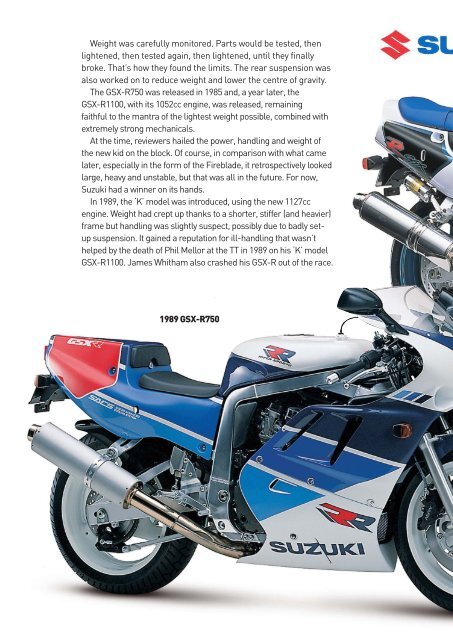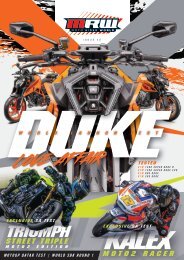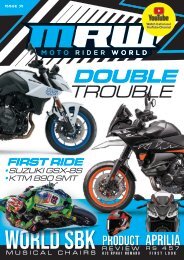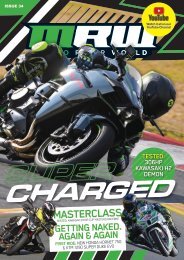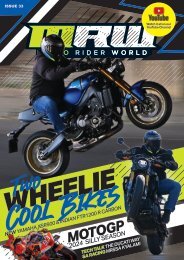FIU Magazine issue 1
Create successful ePaper yourself
Turn your PDF publications into a flip-book with our unique Google optimized e-Paper software.
Weight was carefully monitored. Parts would be tested, then<br />
lightened, then tested again, then lightened, until they finally<br />
broke. That’s how they found the limits. The rear suspension was<br />
also worked on to reduce weight and lower the centre of gravity.<br />
The GSX-R750 was released in 1985 and, a year later, the<br />
GSX-R1100, with its 1052cc engine, was released, remaining<br />
faithful to the mantra of the lightest weight possible, combined with<br />
extremely strong mechanicals.<br />
At the time, reviewers hailed the power, handling and weight of<br />
the new kid on the block. Of course, in comparison with what came<br />
later, especially in the form of the Fireblade, it retrospectively looked<br />
large, heavy and unstable, but that was all in the future. For now,<br />
Suzuki had a winner on its hands.<br />
In 1989, the ‘K’ model was introduced, using the new 1127cc<br />
engine. Weight had crept up thanks to a shorter, stiffer (and heavier)<br />
frame but handling was slightly suspect, possibly due to badly setup<br />
suspension. It gained a reputation for ill-handling that wasn’t<br />
helped by the death of Phil Mellor at the TT in 1989 on his ‘K’ model<br />
GSX-R1100. James Whitham also crashed his GSX-R out of the race.<br />
1989 GSX-R750<br />
1993 GSX-R1100<br />
In 1990, the ‘L’ model was released, with a longer wheelbase to<br />
address the problems with the handling. 1991 saw the ‘M’ model,<br />
which was changed cosmetically and then the ’N’ model which also<br />
had further cosmetic changes.<br />
The next big change came in 1993 with the adoption of water<br />
cooling, which brought an increase in power to 155bhp at the crank.<br />
As with all Suzukis the new engine was extremely strong and could<br />
be tuned to give another 30% power without the need for forced<br />
induction. These new models were designated WP and, several<br />
variations, named WR, WS, WT, WV and WW, followed. Most of the<br />
changes were cosmetic and the engine and suspension and other<br />
components were mildly tweaked.<br />
1998 saw the last of the 1100s and it would be a three year wait<br />
until it was properly replaced.


